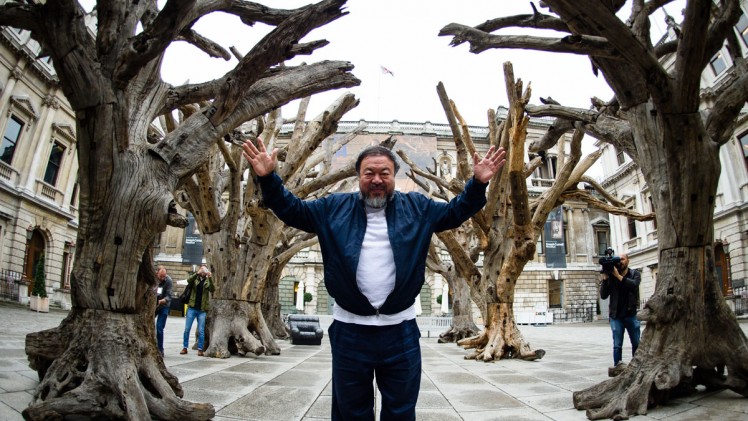Kajol Lally, BA History and Social Anthropology
Ai Weiwei’s first major UK exhibition at the Royal Academy of Art is a thought provoking and intense display of the difficulty faced by many artists. Weiwei deals with challenging themes reflecting human rights, freedom of self-expression and a generation’s political struggle against the Chinese government. The show marks Ai’s freedom from detention by the Chinese authorities and receiving back his passport that had been seized and held since 2011. The RA has completely stepped up their game with this exhibition that has garnered worldwide acclaim.
Upon entering the courtyard, you’re immediately struck by one of Ai’s most organic works. “Tree” is riddled with Weiwei’s attitude, his profound and philosophical perspective on nature, and it also displays one of his recurring traits of taking the old and reforming it. Weiwei created the sculptures by collecting dead trees from the mountains in southern China and reconstructing them into eight magnificent ones. The sculptures were funded through Kickstarter with a staggering 1,319 people raising £123,577 to bring the public piece to life. It resonates with power, strength and life.
Once you enter the academy, the energy of the exhibition is deeply poignant, with many issues resonating through each piece. It’s evident from the very beginning that each piece is sensitive, political, and wrought with emotion that Weiwei wants us to feel – all part of the message he is trying to get across. One monumental sculpture is Straight and, as a piece that’s the heaviest sculpture ever exhibited at the Royal Academy, it is definitely a show stopper. The installation weighs 150 tons and is made up of steel rebar retrieved from the 2008 Sichuan earthquake in commemoration of all the schoolchildren who died. The piece has a significant story to it. Weiwei was horrified when visiting the scene of the earthquake and overwhelmed by the number of bodies he saw, which in turn drove him to investigate the names, ages, birthdays and classes of each child. The information of each individual who died was collected by him and the “data” is shown on the walls around Straight. This project became massive but also resulted in Weiwei being sent to prison for 81 days.
These 81 days in jail are also narrated in a series of six fibreglass dioramas entitled S.A.C.R.E.D. The sculptures are so detailed and tell the story so clearly that you can literally feel the surveillance placed upon the artist. Wei Wei himself describes this time as constant psychological warfare where he was heavily monitored by two guards for the entirety of the period, including when he ate, slept, and urinated.
Ai Wei Wei, often dubbed as China’s most powerful and dangerous man, has been in the limelight in both the artistic and political spheres internationally. We’ve heard of him in recent years as a dissident artist who uses highly symbolic mediums within his art that aim to embody his objection to Chinese authority. Ai is a powerful figure in China, which illustrates the crucial necessity of art as a source of pure social and political commentary. He has gone through remarkable and extraordinary circumstances to produce his art, from being beaten by Chinese authorities and consequently undergoing emergency brain surgery, to being prevented from leaving the country and having his studio demolished by the Chinese government. Ai Wei Wei’s name cannot be searched openly in China without it being deemed an illegal activity, but this has not stopped him from fighting for his art regardless of the oppression and restrictions he faces.
Ai grew up in labour camps after his father, Chinese poet Ai Qing, was accused of “Rightism” for criticising the communist regime during the Anti-Rightist Movement of 1957. While being sent to undertake manual labour in Heilongjiang and Xinjiang, it is clear that as a child Ai Wei Wei had been influenced by his father’s encouragement of free expression and belief that a poet, artist or writer should have the role of critiquing their social framework. This is explicitly shown by Ai Wei Wei’s pioneering work with a full focus on securing social change for the next generation. His work is on display at the Royal Academy of Arts (just half an hour’s walk from SOAS!) until the 13th of December.
We asked: What did you think of the Ai Wei Wei exhibition?
“Ai Weiwei is a brave artist, baring imprisonment and censorship as his muses, however the exhibition relies upon one listening to the free ‘audio guides’ that you’re insistently handed upon entry. You are greeted by the voice of curator Adrian Locke who will tell you the history of each piece, its value as an aesthetic object and political advert; he’ll even go as far as to tell you how to feel when viewing the object. The viewer is left with little to find out themselves and the moment of personal realisation from understanding art is completely removed. The viewer is baraged with sentences like ‘China’s most influential artist’ and ‘greatest living artist’ and although these catchy lines may be true, there is no sign of any other Chinese artist resisting the status quo.The viewer is left with the feeling that Ai Weiwei is the only artist in China using their medium politically, artists like Xu Bing, Zhao Bandi and Ren Hang are ignored completely. This, in my opinion, is doing a disservice to the viewer; the exhibition as a whole leans so greatly on political value it should acknowledge those, even in passing, who have inspired, and joined Ai Weiwei in his controversial critique of Chinese censorship and governance.”
– Luke Lowsley-Williams, BA Social Anthropology

